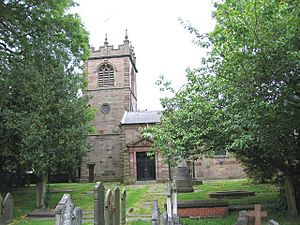St Michael's Church, Flixton facts for kids
Quick facts for kids St Michael's Church, Flixton |
|
|---|---|
| Parish Church of St Michael, Flixton | |

The church seen from the south in June 2009
|
|
| 53°26′31″N 2°22′55″W / 53.44186°N 2.38197°W | |
| OS grid reference | SJ7473093960 |
| Location | 348 Church Road, Flixton, Trafford, Greater Manchester |
| Country | England |
| Denomination | Church of England |
| Previous denomination | Catholic Church |
| Website | stmichaelsflixton.org |
| History | |
| Status | Parish Church |
| Founded | Pre-1066 |
| Dedication | Michael (archangel) |
| Architecture | |
| Functional status | Active |
| Architectural type | Church |
| Style | Georgian architecture and Gothic Revival |
| Specifications | |
| Number of towers | 1 |
| Bells | 8 (full circle) |
| Tenor bell weight | 13 long cwt 3 qr 1 lb (1,541 lb or 699 kg) |
| Administration | |
| Parish | St Michael, Flixton |
| Diocese | Manchester |
| Province | York |
St Michael's Church is a historic Church of England church in Flixton, a part of Greater Manchester. It is a very important building, so it is Grade II* listed, which means it is protected by law. The church is named after Michael the Archangel.
People may have worshipped on this spot even before the Norman Conquest in 1066. The first written records of the church appear around the year 1198. For many centuries, from the 1200s to the 1800s, it was part of the Diocese of Lichfield. Today, it belongs to the Diocese of Manchester.
The church sits on high ground near the River Mersey. This gives it great views over the local area. The building you see today was mostly built in the 1400s, but it includes stone pieces from as far back as the 1100s. The churchyard has gravestones that are hundreds of years old, with the oldest dating back to 1669.
Contents
History of the Church
Ancient Origins
No one knows for sure when the first church was built here. Many believe it was a place of worship before the Normans invaded England in 1066. Some think the name "Flixton" might come from a Viking named Flikke, who may have brought Christianity to the area by building the first church.
In the Middle Ages, Flixton was a parish that included the areas of Urmston and Flixton. A parish is an area that has its own church and priest. The land was granted by the powerful Mascy family of Dunham. Instead of a central village, the area was made up of scattered farms and a manor house.
For about 500 years, St Michael's was connected to the grand Lichfield Cathedral through a special arrangement called a prebend.
The Church Building
The church building has a mix of architectural styles. It is mostly Georgian, a style popular in the 1700s and early 1800s. The tall tower that stands today was rebuilt in 1888. It was built on the old foundations of an even earlier tower from the 18th century.
What's Inside?
It can be hard to trace the church's history just by looking at it, because it has been rebuilt so many times. Historians have found a few clues to its ancient past. In the east wall, you can see two stone pieces from the 12th century decorated with diamond shapes.
The main part of the church, called the chancel, is from the 15th century but has also been rebuilt. Some of the old stonework was likely used again in the newer walls.
The Famous Bells
St Michael's tower has a ring of eight bells. A team of bell ringers still rings them every week for church services and for practice.
The bells have a long history. In 1808, the church had four bells. They were melted down and recast to make a new set of eight. They were recast again in 1938 to improve their sound. The heaviest bell, called the tenor, weighs over 1,700 kilograms and is tuned to the musical note F.
The church has also had a robed choir since the 1870s, which continues to sing at services today.
The Churchyard
The churchyard is filled with history. The oldest gravestone is from 1669, but people were buried here long before that.
Many of the old, flat gravestones have poems carved on them. One famous grave belongs to a blacksmith named William Oldfield. The verse on his stone is said to have been written by the Lancashire poet Tim Bobbin, who was baptised in this church.
People and Community
The church is led by a vicar, The Reverend Huw Thomas. There have been vicars and rectors leading the church since the 12th century.
St Michael's is an active church with many community groups. People can join the bell ringers, the choir, a gardening team, or the Mother's Union. A special group called the Restoration and Development Trust works to take care of the historic building and help the parish grow.
Gallery
See also
- Parish (Church of England)
- List of churches in Greater Manchester
- Listed buildings in Urmston (including Flixton)








